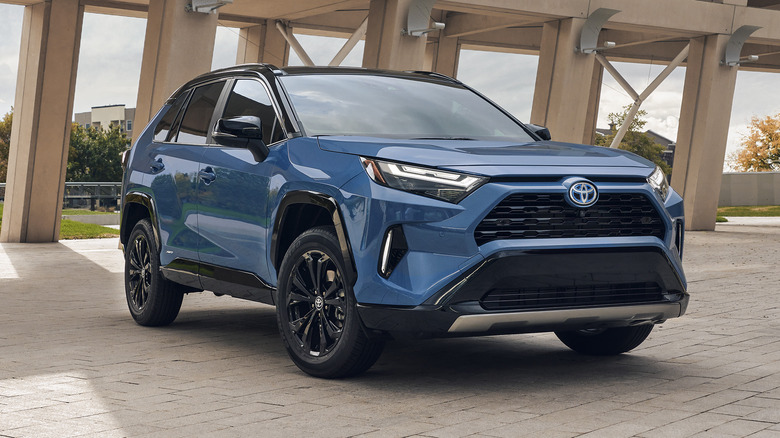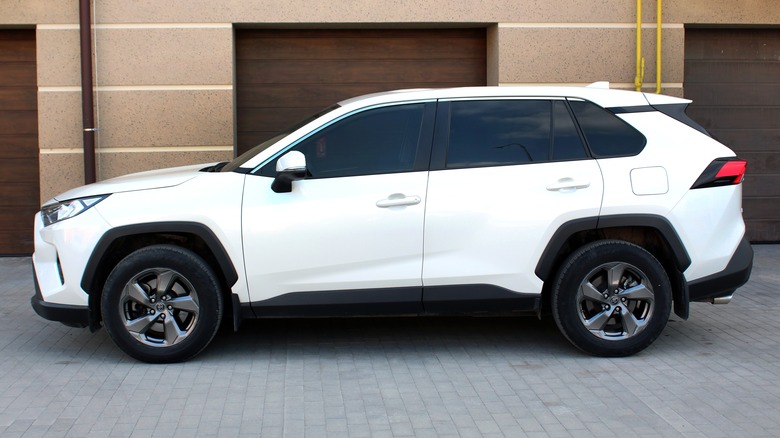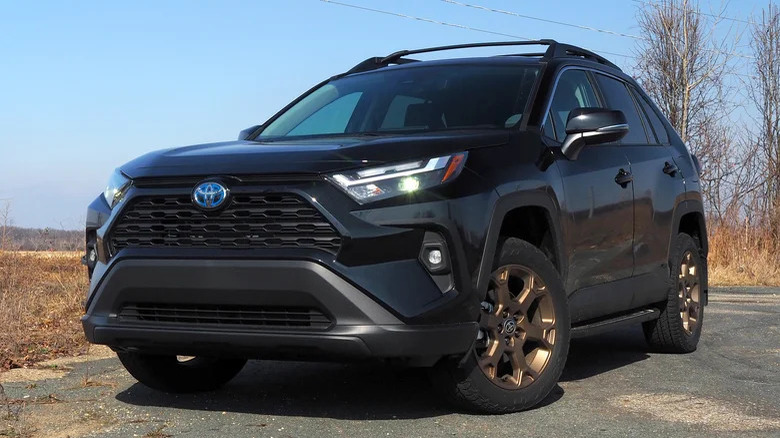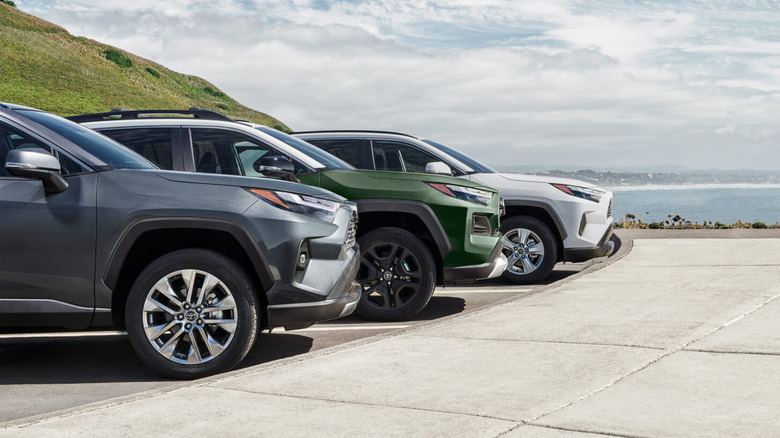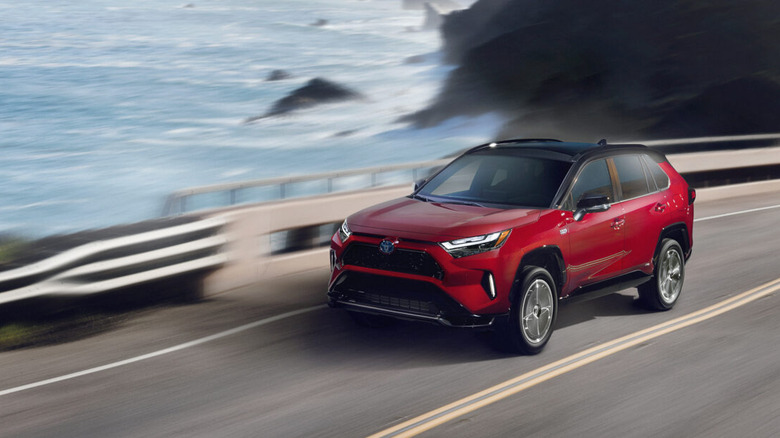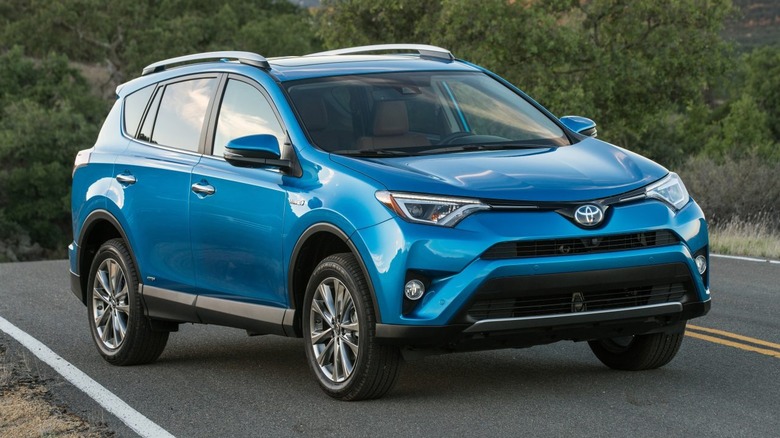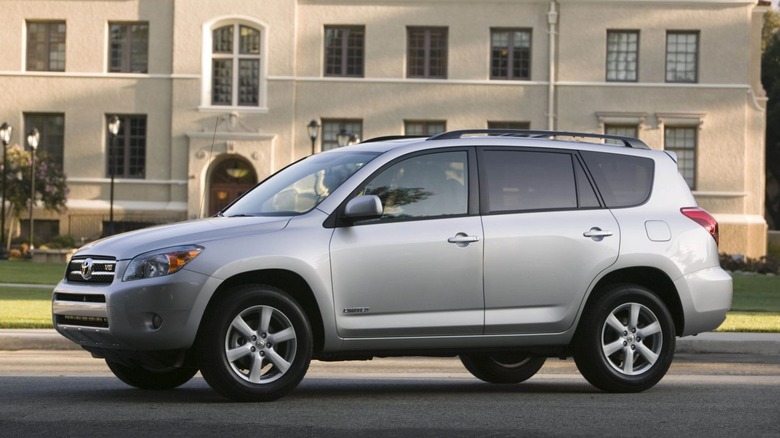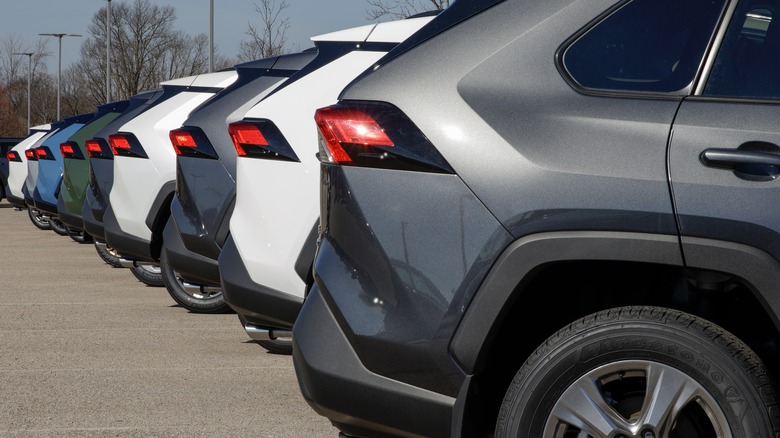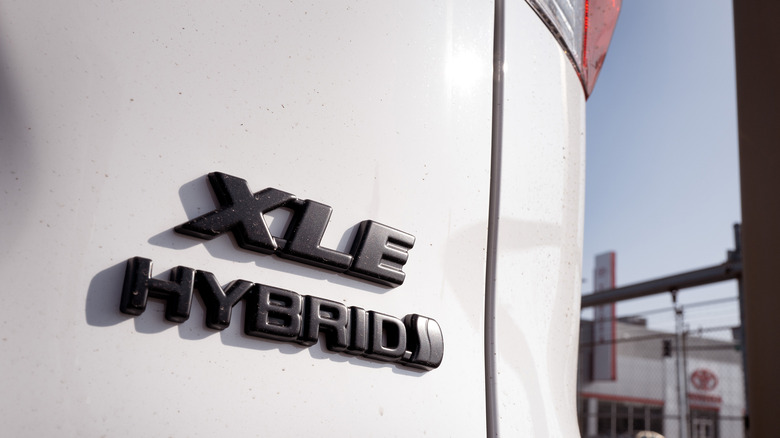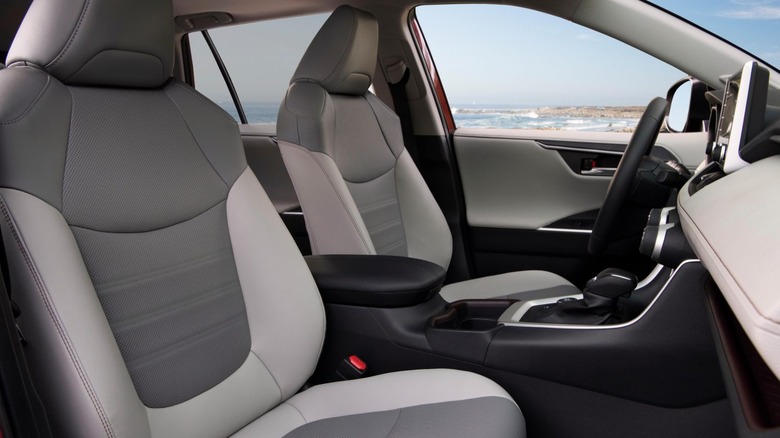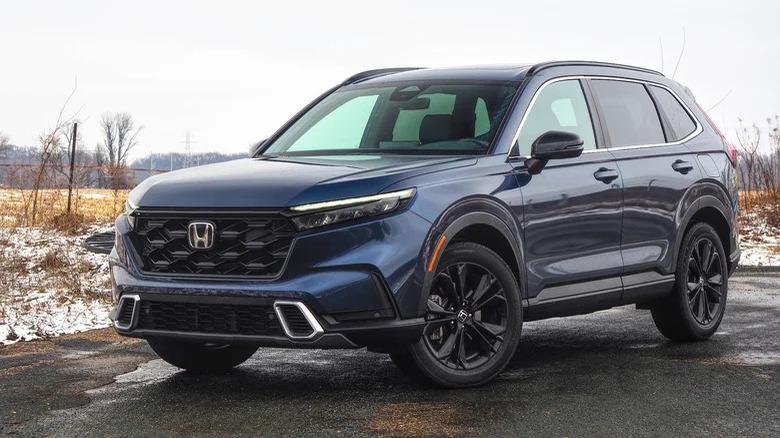10 Things You Should Know Before Buying A Toyota RAV4 (New Or Used)
Buying a car can be a daunting prospect, especially when there is such a wide variety to pick from. Automakers have significantly expanded their lineup of hybrid and electric cars in recent years, and several popular models have been discontinued to make room for them. Even the largest automakers like Toyota have made significant lineup changes, although perennially best-selling models like the RAV4 remain a prominent part of the brand's offering for 2024. Record numbers of buyers chose the RAV4 through the early part of the year, with the hybrid variant seeing its best selling month ever in March. Its popularity is no coincidence either, as there are many good reasons why buyers might want to consider one.
As an automotive market researcher I have spent many hours evaluating popular SUVs and crossovers for SlashGear, and I've consulted with our automotive review team to create a list of things worth knowing before you buy a Toyota RAV4. These tips cover both new and used cars, with the aim of giving you a solid overview of the RAV4 range before you head to a dealership. For a more in-depth evaluation of particular models, I've included links within the text to some of SlashGear's extensive review coverage.
The 2024 RAV4 starts under $30,000
Buyers looking to buy new won't be short on choice, as the 2024 RAV4 is available in a wide variety of trims. The entry-level trim is the LE, which sports an MSRP of $28,675 and offers little in the way of luxuries. At the other end of the range, the Hybrid Limited starts at $40,030 and offers not only a much larger list of standard equipment but also significantly improved economy. A non-hybrid Limited is also available for $36,980, which brings the same interior niceties and added tech but without the greener powertrain.
Base-spec trims get a non-hybrid 2.5L four-cylinder engine that delivers 203 horsepower and 184 lb-ft of torque, while hybrid trims get a power boost to 219 horsepower. The hybrids still feature a 2.5L four-cylinder engine, but with the addition of a single electric motor. Which one to pick will come down to personal preference and budget — hybrid trims superior off-the-line grunt and better economy, but at a roughly $3,000 premium compared to an equivalent non-hybrid trim.
Multiple off-road trims are offered
In the middle of the RAV4 range sits three off-road oriented trims: the hybrid and non-hybrid Woodland Edition, plus the TRD Off-Road. SlashGear's executive editor Chris Davies spent some time with the Hybrid Woodland Edition in 2023 and found it to be a mixed bag, offering a slightly watered-down version of the TRD Off-Road's all-terrain chops but without the full economy benefits of the standard hybrid models. Notably, testing the Hybrid Woodland Edition on a typical mixed driving route revealed significantly lower real-world mpg figures than the officially quoted estimates.
While the off-road tires and roof rails go a long way to making the Hybrid Woodland Edition look the part, they also provide a relatively limited amount of added off-road capability compared to the TRD Off-Road. The Hybrid Woodland Edition features a tuned version of the regular RAV4's suspension, while the TRD Off-Road boasts unique TRD suspension plus a 1/2 inch lift compared to all other trims.
So, while there's nothing wrong with wanting the best of both worlds, there isn't a clear way to get both off-road chops and efficiency in the current range. Buyers looking for the ultimate off-road RAV4 should head for the TRD Off-Road, while those wanting the maximum efficiency gains of the hybrid powertrain will have to sacrifice some all-terrain capability and opt for a road-focused trim.
Efficiency varies significantly between trims
While our experience with the RAV4 Hybrid Woodland Edition proved that EPA figures don't always match up to real-world fuel economy, they still provide a useful benchmark for how efficient one trim is compared to another. The 2024 RAV4's EPA figures vary significantly across the range, with the least efficient trims achieving a combined average of 28 mpg and the most efficient trims averaging 39 mpg.
The worst offender in terms of efficiency is the TRD Off-Road, with its all-terrain modifications dropping its EPA figures to 32 mpg highway, 25 mpg city, and 28 mpg combined. The base-spec non-hybrid RAV4 doesn't do much better, with a one mpg increase in highway efficiency compared to the TRD Off-Road and the same combined mpg.
At the other end of the spectrum sits the hybrid RAV4, which achieves 38 mpg highway, 41 mpg city, and 39 mph combined. All hybrid RAV4 trims are rated with equal mpg figures aside from the Hybrid Woodland Edition, which achieves a combined 37 mpg. In SlashGear's real-world testing, however, the Hybrid Woodland Edition barely reached 30 mpg, significantly less than its EPA estimate.
A plug-in hybrid option is available
Alongside the main range of hybrid and non-hybrid RAV4 models, Toyota also offers a plug-in hybrid model called the RAV4 Prime. It's marketed separately from the main RAV4 lineup and so can be easy to overlook, but offers an even more fuel efficient option for buyers willing to cough up the cash. SlashGear tested the car in 2021, shortly after its launch, and found it to be exactly as expected: a typical RAV4 in all key ways other than the fact that it boasts 40-odd miles of electric-only range.
In this case, that's a good thing, as it means that buyers who are already familiar with the Toyota crossover formula should feel right at home. That said, there is one key downside, namely the PHEV's price. The RAV4 Prime starts at $43,690 for 2024, and as of this writing, no longer qualifies for federal EV tax credit. For context, the more luxurious RAV4 Hybrid Limited starts at $40,030, although its electric-only driving range is negligible.
Whether the extra premium is worth it primarily comes down to how much you value the RAV4 Prime's electric-only range. Buyers who mostly use their cars for shorter urban or suburban trips will see the most benefit, with the lower cost of electricity versus gas helping to balance out the higher upfront cost over time. However, that's assuming the RAV4 Prime is within your budget in the first place.
Not all generations are equal
Buyers on a tighter budget might be considering a used model instead of new, and there are certainly plenty to choose from. The RAV4 has been in constant production since the '90s and has remained a bestseller in its segment for many years, which means the supply of used examples on the market at any given time will be plentiful. As a result, buyers can afford to be choosy, especially since some RAV4 generations have a better reputation than others.
While there aren't any generations that are worth avoiding altogether, it's worth considering your priorities when deciding the age of used examples to consider. The current RAV4 generation debuted in 2019, and so examples from 2019-20 offer the most contemporary experience at a considerably lower cost than new. Previous generation examples (pictured above) are also easy to find used, and span the 2013 to 2018 model years. For anything much older than that, the condition of the car matters more than its age, and so it's worth consulting SlashGear's list of used car buying tips to give you an idea of the main pitfalls to look out for.
The 2007 RAV4 is the most complained about model year
As previously mentioned, there aren't any RAV4 generations that are worth avoiding altogether, but there are some model years that have a higher rate of owner complaints than others. NHTSA data shows that the model year with the most complaints made to the agency is the 2007 RAV4, with 992 complaints. The model was also subject to 14 recalls — considering recalls is important when looking for a used car, as the more recalls a car has had, the more chance there is that a previous owner has not had the required remedial work completed for one or more of them.
The 2006 RAV4 also scores unusually poorly compared to other model years, with 698 complaints and 11 recalls, and the 2019 RAV4 is also a poor performer, with 687 complaints and seven recalls. These complaints represent a tiny fraction of the overall number of RAV4 cars sold each year, and just because one model year scores badly, it doesn't mean it's worth skipping entirely. However, it is something to keep in mind when searching for the most hassle-free used RAV4.
Some RAV4 models are made in America
Like many foreign manufacturers, Toyota makes certain models in America. It won't surprise many people to find out that models focused primarily at U.S. consumers, such as the Tundra pickup and Sequoia SUV, are domestically produced. However, several more globally-focused models, including the Corolla and RAV4 Hybrid, are also built stateside. Buyers wanting to buy an American made RAV4 will have to be careful though, as not all RAV4 cars on sale in America were built in the country.
The RAV4 Hybrid has been built at Toyota's plant in Georgetown, Kentucky since 2020, alongside several other hybrid Toyota and Lexus models. All non-hybrid U.S. market RAV4s are built in Canada. Toyota has two Canadian plants that build both non-hybrid and certain hybrid RAV4 models for North America, one in Cambridge, Ontario, and the other in Woodstock, Ontario. A limited number of U.S. market examples are also built in Japan. So, checking the certification label of an individual example on the forecourt is still the most foolproof way to check exactly where it's made. For most Toyota models, the certification label should be on the driver's side doorjamb.
It will lose around half its value after five years
When buying a new car, it's inevitable that it will depreciate over time, although some models lose value more rapidly than others. According to KBB, the average car loses around 60% of its value over the first five years. A 2024 RAV4 XLE, in comparison, is predicted to lose a little under 50% of its value over the same time period, per KBB estimates. That puts it among the top performers in its segment for retaining value over time, and well above average.
The estimated figure remains fairly consistent across both hybrid and non-hybrid trims, including the PHEV RAV4 Prime. It should be noted that this figure can vary by an individual car's mileage and condition, and should only be intended as a rough benchmark. Still it's useful to have an idea of what a car will be worth when it comes time to upgrade — or, if you're a used buyer, what kind of price you should expect to pay for a five year old example.
Larger buyers might find it slightly cramped
While the RAV4 is a competitively sized SUV for its segment, it might not be a perfect fit for larger buyers. SlashGear's Adam Doud recently bought a 2024 RAV4 Hybrid XLE as his daily driver, and this was one of his few criticisms, alongside the car's uninspiring driving dynamics. The front passenger seat proved to be the trickiest seat in which to get comfortable, with Adam finding that, in order to avoid his head catching the roof, he had to recline noticeably more than he was used to. Also of concern was the width between the door and center console, which he found shorter than ideal.
Another minor flaw that quickly became an inconvenience was the Toyota App's one-user limit. The app can be used to remotely start the car or open the doors, but since only one account can be paired with the car, additional family members are locked out of the added convenience the app offers.
The RAV4 faces tough competition
While it's not without its flaws, it's safe to say that SlashGear's review team has been left generally impressed by their experiences of the RAV4. However, it's far from the only car in its segment to have been scored highly by the team. The Honda CR-V Hybrid was most recently refreshed for the 2023 model year, and offers a similarly practical, hassle-free appeal to the RAV4. For drivers who want maximum enjoyment from their family-friendly crossover, the Mazda CX-50 is also worth considering, although it offers slightly less cargo space than the RAV4.
South Korean automakers like Hyundai and Kia also offer competitively priced rivals, with the Hyundai Tucson winning SlashGear's Select award for 2024 for its impressive value for money and generous equipment levels. There are, then, many competitors that RAV4 buyers should also consider, although the Toyota's combination of practicality, safety, and reliability keeps it a strong competitor in what is today a packed segment.
